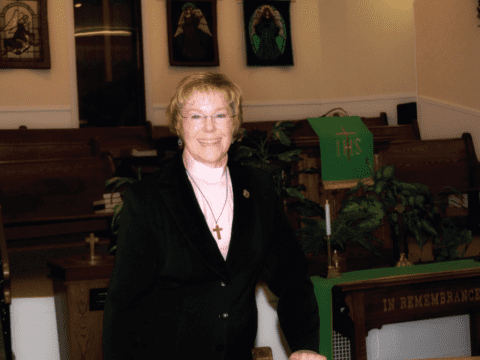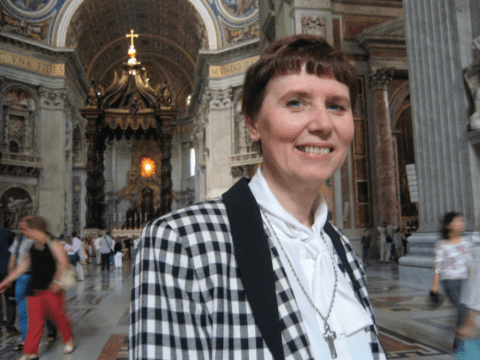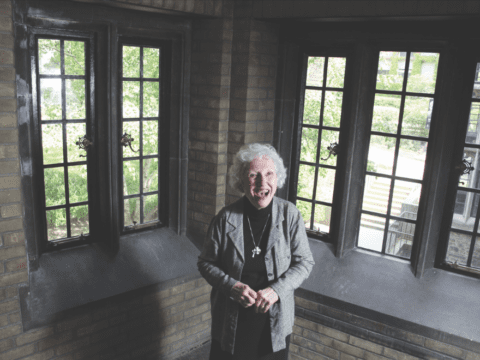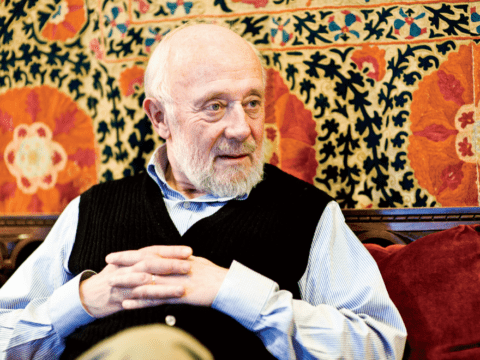The first impression is striking. As you drive west along Annette Street past the intersection of Keele Street in Toronto, you come to a slight bend in the road. No sooner do you negotiate the turn than three enormous red-brick churches and a smaller one come into view. Like phantom bishops emerging from the quiet, leafy neighbourhood, they reassure rather than threaten. Religious or not, you are forced to pause and take stock.
This could be a postcard of any number of Canadian streetscapes. But it would be a postcard heralding a bygone time. All four of the churches on Annette Street are under stress and in transition. Victoria-Royce Presbyterian Church, the first you come upon, closed in 2006 and today is a construction site, its walls blasted out to transform the sanctuary into $15-million worth of high-priced condos. The same is happening at the former Czechoslovak Baptist Church, a block away on the same side of the street. Meanwhile, St. Cecilia’s Roman Catholic Church, on the south side of Annette, is still operating, but the Irish immigrants and their descendants who worshipped there have been mostly replaced by Vietnamese Catholics bused in from across the Greater Toronto Area. The westernmost and largest of the four is High Park Korean United Church, its fortress-like dimensions wildly out of proportion to the small congregation it houses.
The transformation of the churches in these two blocks mirrors changes taking place in other big Canadian cities. Visiting the street is like listening to the whispering of ghosts. What they say is that if you understand their story, you will understand what has happened to so many big city churches across the country.
A hundred and twenty years ago, Canada was primarily an agricultural country. But manufacturing was on the rise. One of the fastest-growing industrial areas in the country was the district just west of Toronto known locally as “the Junction.” Separated from downtown by farmland but connected by a rail line, the Junction was finally annexed by the City of Toronto in 1909. The area attracted major industries, such as Canadian General Electric, the Heintzman piano company and Comfort Soap, as well as meat packing plants, auto manufacturers and the Canadian Pacific Railroad, which operated repair shops and vast freight yards on the Junction’s northern edge.
From a population of 750 in 1888, the town grew to more than 12,000 inhabitants by 1909. Most of the settlers were of British origin, with Annette Street the dividing line between factory workers to the north, and the professional and management class to the south. On Annette rose the churches, four of them within a block and a half. Annette Street Methodist Church came first in 1884, expanding to progressively larger structures in 1887 and 1907 and transforming into High Park United at church union in 1925. Victoria Presbyterian started out as a wooden building in 1885 before moving into the current red-brick structure in 1892. Annette Street Baptist Church was founded in 1888. Eleven years later, St. Cecilia’s laid its cornerstone.
The young neighbourhood had a raucous reputation, its numerous hotels described by the Woman’s Christian Temperance Union as “cesspools of harlotry, vice and iniquity.” In due course, the WCTU carried the day, and temperance, championed by Rev. T. Egerton Shore of Annette Street Methodist, was embraced by a local bylaw in 1904. (Remarkably, the area stayed dry for another 93 years, when a closely fought 1997 referendum struck down the longstanding ban on alcohol sales.)
But there was more to the Methodists of Annette Street than abstinence. On the church’s property, they constructed a Christian education complex, operated a variety of social services, installed public tennis courts and held dances for young people. Junction residents who didn’t use the facilities in the Methodist church had the services of Victoria Presbyterian and its gymnasium, banquet hall and theatre available to them only steps away.
The back wall of High Park United’s sanctuary tell a lot about how the world has changed over the last century. A vast bronze plaque bears the names of more than 200 young people who went off to the First World War. Thirty-eight, whose names are in larger script, never returned. With the Second World War, almost 500 young men and women signed up from High Park and nearby Alhambra United (the two churches would combine their congregations in the mid-1980s). What is astonishing is that any congregation would have had that many 20-year-olds in the first place.
The middle decades of the 20th century were the glory days for churches everywhere in Canada. The churches on Annette Street were no exception. St. Cecilia’s installed new marble altars and statues and promoted the expansion of Catholic education in the Junction through its support of the Loretto Sisters. Despite losing members over its rejection of church union, Victoria Presbyterian still listed close to 1,200 names on its rolls at mid-century. High Park United could fit 1,200 people into its pews, yet at its membership peak in the 1940s, its rolls contained 2,500 names; more than 1,100 children attended Sunday school.
Rev. Arch McCurdy, who served as an interim minister at the amalgamated High Park-Alhambra United during the early 1990s, remembers an old-timer telling him that during the Second World War, if you got to church less than five minutes before the service started, you had to sit on the steps in the gallery.
“Church was the centre of people’s social as well as spiritual calendars,” says Rev. Marjorie Ostrander, who remembers going to Sunday school in the 1950s at High Park United, about a mile’s walk from her house. Her mother led Cub Scout groups while her father served for many years on Presbytery. “There was a huge Sunday school, junior, intermediate and senior choirs, numerous UCW units,” she says.
Things began to change in the late 1960s. Church families, or at least their young, were moving out of the neighbourhood, and a new wave of immigrants from central Europe moved in. This was good news for local Catholics, who built four new churches, but not for Protestants. By the 1970s, “the writing was on the wall,” says Ostrander. In 1969, Victoria Presbyterian merged with another struggling church from the district, Royce Presbyterian. In 1976, the Baptist Convention of Ontario and Quebec rented Annette Street Baptist to a Czechoslovakian congregation whose members mostly commuted to Sunday services from far-flung corners of the Toronto region.
Local historian Matthew Hayles reports that by the time Victoria-Royce Presbyterian closed in 2006, fewer than 30 people were attending worship, yet the annual heating bill alone was in the order of $30,000. When he attended a service a couple of years ago at Czechoslovak Baptist, the historian says he counted six people in the sanctuary.
The shift in the second half of the 20th century was profound, and Sandy McIntyre was part of it. McIntyre, a lawyer, works in the same Junction firm his grandfather founded 109 years ago. That grandfather, W.A. McMaster, was a Junction pioneer, temperance crusader and pillar of High Park United. McIntyre spent the first three years of his life living in an apartment in his grandparents’ sprawling house on High Park Avenue. But then in the 1960s, his parents joined what was becoming a general exodus to the suburbs.
Nevertheless, McIntyre’s family returned to the Junction every Sunday for church, followed by dinner at his grandparents’ house. His father, Roy, took over the task of church pillar, serving on the Board.
Roy’s funeral was held at High Park United in 1978. A year later, McIntyre was married there. Even so, McIntyre had begun to drift away from organized religion, attending church only sporadically after university. The couples’ club at High Park United had formed a big part of his parents’ social life. Not so for McIntyre and his spouse.
Arch McCurdy says that by the time he stepped into High Park-Alhambra United’s empty pulpit in 1992, “our services would have 35 people, everybody sitting where they used to sit three decades earlier when the church was full.” McCurdy remembers Rev. George Gibb, his Presbyterian counterpart down the street, commiserating, “I guess they’ve all fled.”
In 1996, High Park-Alhambra United struck a deal with a Korean congregation, Hanuhl, to take over the church building for$1. The old congregation continued as a tenant for three more years before folding altogether. Today, a Portuguese Pentecostal congregation rents the church for its services.
In 2011, the plaster on the soaring ceiling is flaking above the great horseshoe sanctuary and its 60-pipe organ. On a late-winter Sunday, about 50 parishioners sit in the pews. It’s now their turn to keep the monster building going. Rev. Young Rhee takes me on a quick tour, walking down the empty corridors from one room to the next. Board member Sam Chan mentions that the boiler quit last winter, “but fortunately someone knew a Korean guy who knew a lot about boilers.”
Chan drives an hour each Sunday to be part of both the English- and Korean-language services, and the lunch and business meeting that follow. Like Chan, almost all the other members commute to church from across the Greater Toronto Area. They come together out of a sense of community, says Chan, even though the building is far too big and a challenge to heat. It strikes me that the number of congregants on the Sunday I attend is about equal to the number of Methodist 20-year-olds killed in the First World War.
While the original churchgoing population of the Junction is long gone, it’s not as is the neighbourhood is vacant. Today, playing fields are packed with minor-league soccer players, and sidewalks in the shopping areas are gridlocked with young parents pushing baby strollers. Why did the churches not connect with the new generations? According to Rev. Bill Bruce, they may have partly been victims of their own success. Bruce served briefly as High Park United’s interim minister as the congregation was closing down in the 1990s. Up until the middle years of the last century, churches like the four on Annette Street pretty much guaranteed themselves a central role in the life of the community by offering a full range of services. “In the 1930s in Toronto,” he points out, “you could not access social services unless you could produce proof of belonging to a church; you could only participate in amateur sport through church leagues. People went to church to get primary childcare, to dance, to socialize, to meet members of the opposite sex.”
When churches began to lobby governments to take over the tasks of social care, says Bruce, they helped to seal their own fate. Governments provided more services, and churches eventually lost their central place in the community
Bruce, now minister at Thornhill (Ont.) United, lives just south of the Junction, coincidentally in one of 24 condos carved out of what was once Howard Park United. A segment of stained glass window peeks into his living room. A former lawyer, Bruce has plenty of experience in dealing with church real estate. Two of the four churches on Annette Street have already taken the difficult step he feels far more struggling United churches need to take: put out a for sale sign. Using Toronto as his example, he declares, “It’s absurd that we hold a billion dollars worth of real estate to serve 25,000 people. All those 1890s buildings are going to kill us.”
He points out that letting go of real estate is nothing new. The United Church was created because its three founding denominations agreed that operating separately made no sense. “Lots of congregations were amalgamated and buildings closed” as part of church union in 1925, says Bruce.
And yet, we like our church buildings; they call out to us.
What do we experience when we pass churches like High Park Korean United and its neighbours? Nostalgia for a bygone time when Christianity was muscular and all-encompassing? Or perhaps a longing for a sense of local connection?
Sandy McIntyre rarely attends church these days. Still, he says, “I felt a loss when they closed the congregation” at High Park-Alhambra United. And he says he’ll feel a loss if they ever tear the building down — or turn it into condos. “At the same time,” he admits, “when push came to shove, I didn’t do anything to save it.”
***
This story first appeared in The United Church Observer’s September 2011 issue with the title “The ghosts of Annette Street.”















